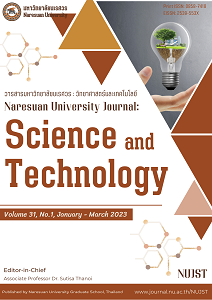PLA Improvement Using Nanocomposite and Plasma Modification
DOI:
https://doi.org/10.14456/nujst.2023.6Keywords:
Low-temperature plasmas, PLA modification, Nanocomposite, Plasma modifications, Surface modificationsAbstract
This work studied the effects of Oxygen (O2), Nitrogen (N2) and Air plasmas on the surface modification of Polylactic acid (PLA) films. PLA films with 0.01 mm thickness were prepared from pure PLA material, while the PLA nanocomposite was prepared by mixing pure PLA with 5.00 wt.% of Organoclay (Cloisit® 30B). The plasma discharge was operated by -800 VDC of applied voltage at 0.1 mbar. The samples were placed on the substrate inside the plasma reactor and exposed to the plasma gases for 10, 15 and 20 min. The results showed that the hydrophobic property of pure PLA film can be increased by O2 exposure for 10 min and air plasma exposure for 20 min. Whilst the hydrophilic properties of PLA nanocomposite film were elevated when exposed for 20 min to the air and N2 plasma. In addition, PLA nanocomposite film has slightly higher levels of hydrophilic properties when compared to pure PLA film as evidenced by contact angle measurement. This result implies that low-temperature plasma discharges can successfully improve the surface property of PLA film in a short operating time.
References
Armentano, I., Bitinis, N., Fortunati, E., Mattioli, S., Rescignano, N., Verdejo, R., … Kenny, J. M. (2013). Multifunctional nanostructured PLA materials for packaging and tissue engineering. Progress in Polymer Science, 38(10–11), 1720-1747. http://dx.doi.org/10.1016/j.progpolymsci.2013.05.010
Bogaerts, A., Neyts, E., Gijbels, R., & van der Mullen, J. (2002). Gas discharge plasmas and their applications. Spectrochimica Acta Part B: Atomic Spectroscopy, 57(4), 609-658. http://dx.doi.org/10.1016/s0584-8547(01)00406-2
Borcia, I.-L. P. a. G. (2013). Surface modification and stability of polymers treated by atmospheric-pressure helium plasma. Journal of Advanced Research in Physics, 4(1), 011305.
Conrads, H., & Schmidt, M. (2000). Plasma generation and plasma sources. Plasma Sources Science and Technology, 9(4), 441.
Dadbin, S., Naimian, F., & Akhavan, A. (2011). Poly(lactic acid)/layered silicate nanocomposite films: Morphology, mechanical properties, and effects of γ-radiation. Journal of Applied Polymer Science, 122(1), 142-149. http://dx.doi.org/10.1002/app.33985
Da Ponte, G., Sardella, E., Fanelli, F., d’Agostino, R., Favia, P. (2011). Trends in surface engineering of biomaterials: atmospheric pressure plasma deposition of coatings for biomedical applications. The European Physical Journal Applied Physics, 56(2), 4. http://dx.doi.org/10.1051/epjap/2011110192
De Geyter, N., Morent, R., Desmet, T., Trentesaux, M., Gengembre, L., Dubruel, P., . . . Payen, E. (2010). Plasma modification of polylactic acid in a medium pressure DBD. Surface and Coatings Technology, 204(20), 3272-3279. http://dx.doi.org/10.1016/j.surfcoat.2010.03.037
Eliezer, S. E. a. Y. (2001). The fourth state of matter: An introduction to plasma science (2rd ed.). Bristol and Philadelphia: Institute of Physics Publishing.
Fu, S., & Zhang, P. (2019). Surface modification of polylactic acid (PLA) and polyglycolic acid (PGA) monofilaments via the cold plasma method for acupoint catgut-embedding therapy applications.Textile Research Journal, 89(18), 0040517518824841. http://dx.doi.org/10.1177/0040517518824841
Junkar, I., Cvelbar, U., & Lehocký, M. (2011). Plasma treatment of biomedical materials. Materiali in Tehnologije, 45, 221-226.
Kaew-On, C., Chittrakarn, T., Ruangdit, S., Yuenyao, C., & Tirawanichakul, Y. (2018). Modification of Asymmetric Polysulfone Membrane Surfaces using Mixed Ar/O2 Plasma Technique. Walailak Journal of Science and Technology, 16(6), 423-431. http://dx.doi.org/10.48048/wjst.2019.4773
Oehr, C. (2003). Plasma surface modification of polymers for biomedical use. Nuclear Instruments and Methods in Physics Research Section B: Beam Interactions with Materials and Atoms, 208, 40-47. http://dx.doi.org/10.1016/S0168-583X(03)00650-5
Othman, S., Edwal, S., Risyon, N., Kadir, R., & Talib, R. (2017). Water sorption and water permeability properties of edible film made from potato peel waste. Food Science and Technology (Campinas), 37, 13. http://dx.doi.org/10.1590/1678-457x.30216
Rhim, J.-W., Hong, S.-I., & Ha, C.-S. (2009). Tensile, water vapor barrier and antimicrobial properties of PLA/nanoclay composite films. LWT - Food Science and Technology, 42(2), 612-617. http://dx.doi.org/10.1016/j.lwt.2008.02.015
Richter, C., Reinhardt, M., Giselbrecht, S., Leisen, D., Trouillet, V., Truckenmüller, R., . . . Welle, A. (2010). Spatially controlled cell adhesion on three-dimensional substrates. Biomedical microdevices, 12, 787-795. http://dx.doi.org/10.1007/s10544-010-9433-2
Xu, W., Rajan, K., Chen, X., & Sarkar, D. (2019). Facile electrodeposition of superhydrophobic aluminum stearate thin films on copper substrates for active corrosion protection. Surface and Coatings Technology, 364, 406-415. http://dx.doi.org/10.1016/j.surfcoat.2019.02.070
Yuenyao, C., Chittrakarn, T., Tirawanichakul, Y., & Nakajima, H. (2017). Low Pressure DC-Plasma System for the Modification of Polymeric Membrane Surfaces. Sains Malaysiana, 46, 783-793. http://dx.doi.org/10.17576/jsm-2017-4605-13
Yuenyao, C., Chittrakarn, T., Tirawanichakul, Y., & Sirijarukul, S. (2016). Surface Modification of Asymmetric Polysulfone/Polyethylene Glycol Membranes by DC Ar-Glow Discharge Plasma. International Journal of Polymer Science, 2016, 4759150. http://dx.doi.org/10.1155/2016/4759150
Downloads
Published
How to Cite
Issue
Section
License
Copyright (c) 2023 Naresuan University Journal: Science and Technology

This work is licensed under a Creative Commons Attribution-NonCommercial 4.0 International License.














